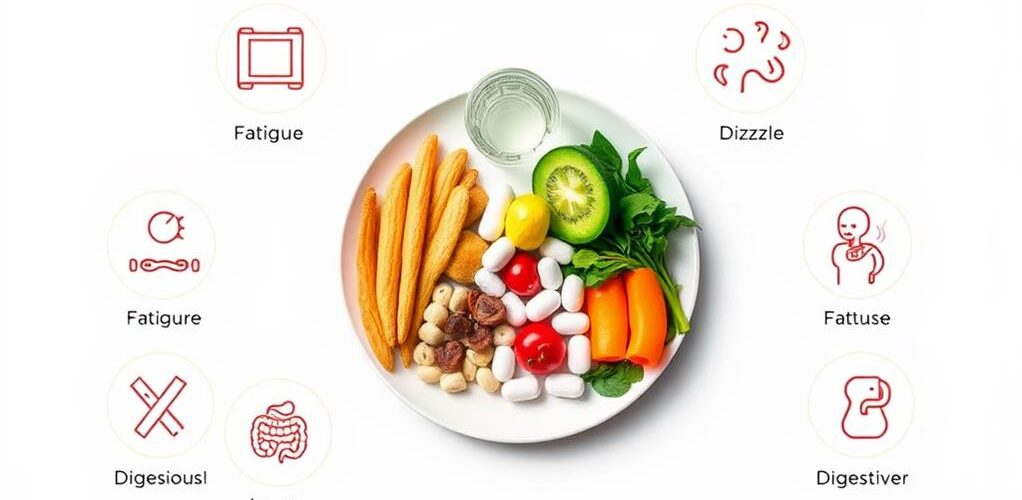
Starting a keto diet can cause some pretty annoying side effects like the "keto flu" with headaches, fatigue, and brain fog! Drink a lot of water, at least 8-10 cups, and get those electrolytes by eating avocados and nuts. Watch out for tummy troubles like constipation; eating fiber-rich foods like flax seeds helps a ton. Kidney stones? Yup, that's a risk too, so stay hydrated! If you're feeling extra lousy, it might be ketoacidosis, especially for diabetics—so keep an eye on those ketone levels. And if you're worried about long-term effects, there's a lot more to learn about staying healthy while on keto.
Key Takeaways
- Prevent Keto Flu: Stay hydrated and maintain electrolyte balance with foods like avocados and spinach to avoid headaches and fatigue.
- Manage Dehydration: Drink 2-3 liters of water daily to combat symptoms like dizziness and dry mouth from increased water loss.
- Avoid Gastrointestinal Issues: Include fiber-rich keto foods like flax seeds and leafy greens to reduce constipation and diarrhea.
- Monitor Kidney Health: Regularly check kidney function and stay hydrated to lower the risk of kidney stones and ketoacidosis.
- Consult Professionals: Seek guidance from a registered dietitian to ensure proper nutrient intake and address individual health needs.
Common Keto Flu Symptoms
Initiating a ketogenic diet often leads to a phase known as the "keto flu," characterized by a collection of symptoms that commonly include headaches, fatigue, nausea, and irritability.
These symptoms typically last a few days to a week, making the initial phase of ketosis quite challenging for many. The body's shift from using carbohydrates to ketones for energy can feel like a rocky change, with mood changes such as irritability and brain fog adding to the discomfort.
But don't worry, there are keto flu remedies that can help! Staying hydrated and consuming foods rich in electrolytes are essential. Dehydration and electrolyte imbalances are major contributors to keto flu symptoms, so drinking plenty of water and eating foods high in sodium, potassium, and magnesium can ease the discomfort. Muscle cramps, another common issue, often arise due to these imbalances.
Incorporating electrolyte-rich foods and staying hydrated can help shorten the symptom duration. Think of it as giving your body the tools it needs to adjust smoothly.
While the keto flu can be tough, understanding these remedies can make the change into ketosis more manageable and less intimidating.
Managing Dehydration
Dehydration is a common early side effect of the keto diet, causing symptoms like dark urine, dizziness, and dry mouth.
It's important to drink water throughout the day and consider adding electrolytes like sodium, potassium, and magnesium to your diet to help manage these symptoms.
Eating hydrating foods, such as leafy greens and cucumbers, can also support your hydration efforts.
Recognizing Dehydration Symptoms
One of the early hurdles of shifting to a ketogenic diet is managing the symptoms of dehydration, which often stem from the significant water loss accompanying the depletion of glycogen stores.
Dehydration causes a range of discomforts that can make the initial stages of keto quite challenging. Recognizing these symptoms is essential for effective dehydration prevention.
Look out for signs like dark urine, dizziness, dry mouth, increased thirst, and fatigue. These symptoms typically appear during the first few weeks as your body adapts to the reduced carbohydrate intake.
Why does this happen? When your body burns through its glycogen stores, it releases water, leading to increased urination and a higher risk of dehydration.
To prevent these symptoms, focus on staying hydrated. The keto diet's diuretic effect means you might need to drink more water than usual—around 2-3 liters per day.
Also, keep an eye on your electrolyte balance. Consuming enough sodium, potassium, and magnesium through food or supplements can help maintain your hydration levels.
Hydration Best Practices
Effective hydration management is essential during the initial phases of a ketogenic diet due to the increased risk of dehydration. As your body shifts to burning fat, it tends to lose more water, leading to symptoms like dark urine, dizziness, dry mouth, and fatigue. These can make you feel pretty crummy, but don't worry, there are ways to tackle this!
First, one of the key hydration strategies is to drink plenty of water—aim for at least 8-10 cups each day. If you're active, you might need even more. Keep a water bottle handy and sip throughout the day.
It's not just about drinking plain water; you can also get fluids from various fluid sources. Herbal teas, broths, and even water-rich foods like cucumbers and berries can help keep you hydrated.
Hydration isn't just about quenching your thirst; it's vital for kidney function and overall health, especially when starting keto.
Electrolyte Balance Tips
Managing electrolyte balance is paramount when following a ketogenic diet, as the body's shift in metabolism frequently leads to significant changes in fluid and mineral levels. Staying hydrated is essential on the keto diet. When you don't drink enough water, you might feel tired or get headaches. Aim for at least 8-10 cups of water daily to avoid these issues.
Electrolyte imbalances can happen because you're eating fewer carbs. To keep your fluids in check, consider electrolyte supplements. Sodium, potassium, and magnesium are key players here. For instance, eating foods rich in these minerals—like avocados, spinach, and nuts—can help replenish what you lose.
Keeping an eye on your electrolyte levels is super important. If you don't, you might end up with muscle cramps or dizziness, also known as keto flu.
Adding a pinch of sea salt to your meals or drinks can boost your sodium intake, helping you stay hydrated and balanced.
Gastrointestinal Issues

Shifting to a ketogenic diet can often lead to gastrointestinal issues, greatly impacting one's digestive health. Common problems include constipation, diarrhea, nausea, and vomiting. These symptoms frequently arise from drastic dietary changes and a significant reduction in fiber sources. High-fiber foods like fruits and whole grains are limited on the keto diet, which can worsen digestive discomfort.
To help manage these issues, follow these tips:
- Include Fiber-Rich Keto Foods: Opt for flax seeds, chia seeds, and leafy greens. These foods can help maintain digestive health without breaking ketosis.
- Stay Hydrated: Drinking plenty of water can aid in digestion and prevent constipation. Herbal teas and broths are also good options.
- Introduce Fats Gradually: To avoid diarrhea, gradually increase your fat intake. This allows your digestive system to adapt more smoothly.
- Consult a Dietitian: A registered dietitian can provide personalized advice, ensuring you get adequate nutrients while managing gastrointestinal symptoms.
Research shows that around 65% of children on the keto diet experience constipation, highlighting the importance of these strategies.
Gradually adapting to the diet and seeking professional guidance can make a significant difference in maintaining digestive comfort and overall health.
Risk of Kidney Stones
Beyond gastrointestinal issues, another significant concern for those adhering to a ketogenic diet is the increased risk of kidney stones. This risk arises because the keto diet can lead to higher levels of uric acid and calcium in the urine, both of which can contribute to kidney stone formation. If you're following a high-fat, low-carb diet, this is particularly important to know.
Dehydration is another culprit. When you're on the keto diet, it's easy to get dehydrated, which can make kidney stones more likely to form. Drinking lots of fluids is essential for kidney stone prevention. Imagine your urine like a river; if it gets too concentrated, it's easier for stones to form.
A study found that people on the keto diet, especially those eating lots of animal-based proteins and fats, might see a higher incidence of kidney stones.
Regularly monitoring your kidney function and urine composition is smart, especially if you've had kidney stones before. Think of it like keeping an eye on the fuel gauge in your car; you don't want to run out of gas, right?
Ketoacidosis Concerns

Ketoacidosis is a really serious condition where too many ketones make your blood too acidic, which can be super dangerous if not treated fast.
If you have type 1 diabetes, you're at a higher risk because you need insulin to keep ketone levels in check.
Knowing the symptoms like nausea and fruity-smelling breath, and regularly checking your blood ketone levels, especially when starting a keto diet, is key to staying safe.
Recognizing Ketoacidosis Symptoms
Recognizing the symptoms of ketoacidosis is vital, particularly for individuals with type 1 diabetes or those with insulin deficiencies.
Ketoacidosis occurs when high levels of ketones lead to a dangerously acidic environment in the blood. This condition can be life-threatening and needs immediate medical attention. Unlike ketosis, which is a normal metabolic state, ketoacidosis triggers serious health issues.
To identify ketoacidosis, look out for the following symptoms:
- Nausea and Vomiting: Feeling sick to your stomach or throwing up frequently.
- Abdominal Pain: Experiencing severe stomach pain that doesn't go away.
- Rapid Breathing and Confusion: Breathing really fast or feeling very confused and out of it.
- Fruity-Smelling Breath: Noticing a sweet, fruity smell in your breath due to heightened acetone levels.
Blood ketone monitoring is essential for anyone with diabetes to tell the difference between safe ketosis and dangerous ketoacidosis. This helps in managing the condition effectively.
Additionally, risk factors like inadequate insulin dosage, severe dehydration, and prolonged fasting can increase the chances of developing ketoacidosis.
Risks for Diabetics
For individuals with diabetes, particularly those with type 1 diabetes, the ketogenic diet presents unique challenges and risks. One of the biggest concerns is ketoacidosis, a dangerous condition where blood becomes too acidic due to high ketone levels. This can be life-threatening and needs immediate medical attention. Symptoms like nausea, vomiting, abdominal pain, and confusion should never be ignored.
Type 1 diabetics must pay extra attention to blood monitoring to spot the difference between safe ketosis and harmful ketoacidosis. Regular checks can help you stay on the right side of health.
Adjusting insulin is another essential part of managing diabetes on a keto diet. If you're on insulin therapy, it's crucial to make insulin adjustments because low carbohydrate intake can cause blood sugar to plummet, leading to hypoglycemia.
Research shows that type 1 diabetics on keto diets face almost one low blood sugar event daily, which makes careful management of both insulin and carbs necessary.
Prevention and Monitoring
Effective prevention and monitoring are paramount in mitigating the risk of ketoacidosis, particularly for individuals with type 1 diabetes. This serious condition is marked by dangerously high levels of ketones and blood acidity. Understanding how to prevent and monitor ketoacidosis can help avoid a medical emergency.
1. Blood Monitoring: Regularly checking blood ketone levels is essential. This helps distinguish between ketosis, which is a normal part of the keto diet, and ketoacidosis, which is dangerous.
Keeping an eye on blood glucose levels is also vital because high blood sugar can indicate an impending problem.
2. Hydration Strategies: Dehydration can worsen ketoacidosis. Drink plenty of water throughout the day and consider electrolyte supplements to maintain balance.
This will help prevent the electrolyte imbalances that can trigger or worsen ketoacidosis.
3. Symptom Awareness: Recognize symptoms like nausea, vomiting, abdominal pain, confusion, and excessive thirst.
If you experience these, seek medical attention immediately.
4. Consult Healthcare Providers: Before starting the keto diet, it's essential to talk to healthcare providers, especially if you have existing medical conditions.
They can offer personalized advice and help develop a safe plan for managing blood sugar and ketone levels.
Reduced Athletic Performance
During the initial adaptation phase of the ketogenic diet, athletes often encounter a noticeable decline in performance, especially in high-intensity activities.
This performance adaptation period can be tough, as the body adjusts to using fat instead of carbohydrates for energy. Imagine trying to run a race with a new pair of shoes that haven't been broken in yet—it's not exactly comfortable.
Studies show that cyclists and runners on keto diets might see their performance metrics drop, making endurance and strength training a real challenge.
Energy fluctuations during this time can make athletes feel less energetic, like their usual pep has taken a vacation. This adjustment period can last from a few days to several weeks, and it's different for everyone. Some athletes might adapt quickly, while others struggle to regain their peak performance.
Despite these initial hurdles, there's light at the end of the tunnel.
Continued research suggests that once fully adapted, some athletes report improved endurance. So, it's not all doom and gloom.
Think of it as the body's way of saying, "Hold on, I'm figuring this out!" With time and patience, many athletes find their groove again.
Nutrient Deficiencies

Adopting a ketogenic diet can inadvertently lead to nutrient deficiencies due to its restrictive nature. This diet often limits a variety of nutrient-dense foods, which can result in deficits of essential vitamins and minerals such as calcium, vitamin D, magnesium, and potassium. These nutrients are critical for maintaining overall health, and their absence can lead to significant health issues.
To prevent these deficiencies, consider the following dietary strategies:
- Include Diverse Nutrient Sources: Incorporate low-carb vegetables like spinach and kale to boost intake of essential vitamins and minerals.
- Supplement Wisely: Take supplements for nutrients that are hard to obtain from a ketogenic diet, such as vitamin D and magnesium.
- Consult a Professional: Work with a registered dietitian to create a balanced meal plan that guarantees adequate nutrient intake.
- Monitor Fiber Intake: Increase fiber through keto-friendly options like flaxseeds and chia seeds to avoid digestive issues like constipation.
Nutrient deficiencies are particularly concerning for children who may experience growth and development issues if their diet is not properly managed. As a result, careful planning and professional guidance are crucial to maintaining a healthy ketogenic lifestyle.
Long-term Health Risks
While managing nutrient deficiencies is critical, it is equally important to take into account the long-term health risks associated with a ketogenic diet. One major concern is cardiovascular health. Relying on saturated fats can boost low-density lipoprotein (LDL) cholesterol levels, which isn't great news for your heart. Higher LDL levels can increase the risk of heart disease, a key worry for anyone on the keto path.
Bone health also takes a hit with this diet. Long-term keto followers, especially children, have shown a drop in bone mineral density. This means bones can become weaker and more prone to fractures. Think of it like trying to build a house with brittle bricks—it's just not going to hold up well.
Kidney stones are another painful possibility. A high-fat, animal-based diet can lead to acidic urine and calcium excretion, making those pesky stones more likely.
And don't forget the studies that have linked low-carb, animal-based diets to higher mortality rates. It's a sobering thought.
Suitability for Individuals

The ketogenic diet, often lauded for its potential benefits in weight management and certain health conditions, particularly metabolic disorders and epilepsy, demands careful evaluation regarding its suitability for various individuals.
While it has shown promise, the keto diet suitability varies widely among different people. Here's what you need to know:
1. Health Conditions: The keto diet is not recommended for individuals with pre-existing pancreatic, thyroid, or liver conditions. The high-fat content of the diet could potentially worsen these issues.
Those with kidney problems should also steer clear due to the high protein intake, which can lead to kidney stones.
2. Professional Guidance: Consulting with a registered dietitian before starting the keto diet is essential. They can tailor the diet to your personal health needs and guarantee that you get the right nutrients.
3. Weight Loss Variability: The potential for weight loss on the keto diet varies from person to person. Some might see great results, while others might struggle with the strict dietary limits and long-term adherence.
4. Individual Health: Everyone's body is different. What works for one person might not work for another. It's important to reflect on your overall individual health before diving into the keto diet.
Understanding these points can help you make a more informed decision.
Frequently Asked Questions
How Do You Prevent Keto Symptoms?
To prevent keto symptoms, employ hydration strategies and maintain electrolyte balance. Consuming foods rich in potassium, magnesium, and sodium, alongside gradual carbohydrate reduction and high-fiber foods, can effectively mitigate issues like dizziness, fatigue, and gastrointestinal discomfort.
What Are the Serious Side Effects of Keto?
Serious side effects of the keto diet include ketoacidosis, increased risk of kidney stones, nutrient deficiencies, raised LDL cholesterol, and psychological effects. Keto flu and electrolyte imbalance are common initial symptoms that can exacerbate these issues.
How Do I Stop Keto Safely?
To stop keto safely, follow these keto change tips: gradually reintroduce carbohydrates, starting with complex carbs like whole grains, fruits, and vegetables. Guarantee adequate hydration, consume nutrient-dense foods, and monitor your body's response during the change.
What Are the Common Problems of Keto Diet?
The common problems of the keto diet include keto flu, characterized by fatigue and headaches, and intense carb cravings. Additionally, gastrointestinal issues, dehydration, kidney stones, and long-term nutrient deficiencies can also occur.
Conclusion
To sum up, while the ketogenic diet offers potential benefits, it also comes with several side effects that must be carefully managed. From keto flu symptoms and dehydration to gastrointestinal issues and the risk of kidney stones, individuals must be well-informed and take proactive measures to mitigate these risks. Additionally, concerns about ketoacidosis, reduced athletic performance, nutrient deficiencies, and long-term health impacts should not be overlooked. As a result, suitability should be assessed on an individual basis.









No Comments